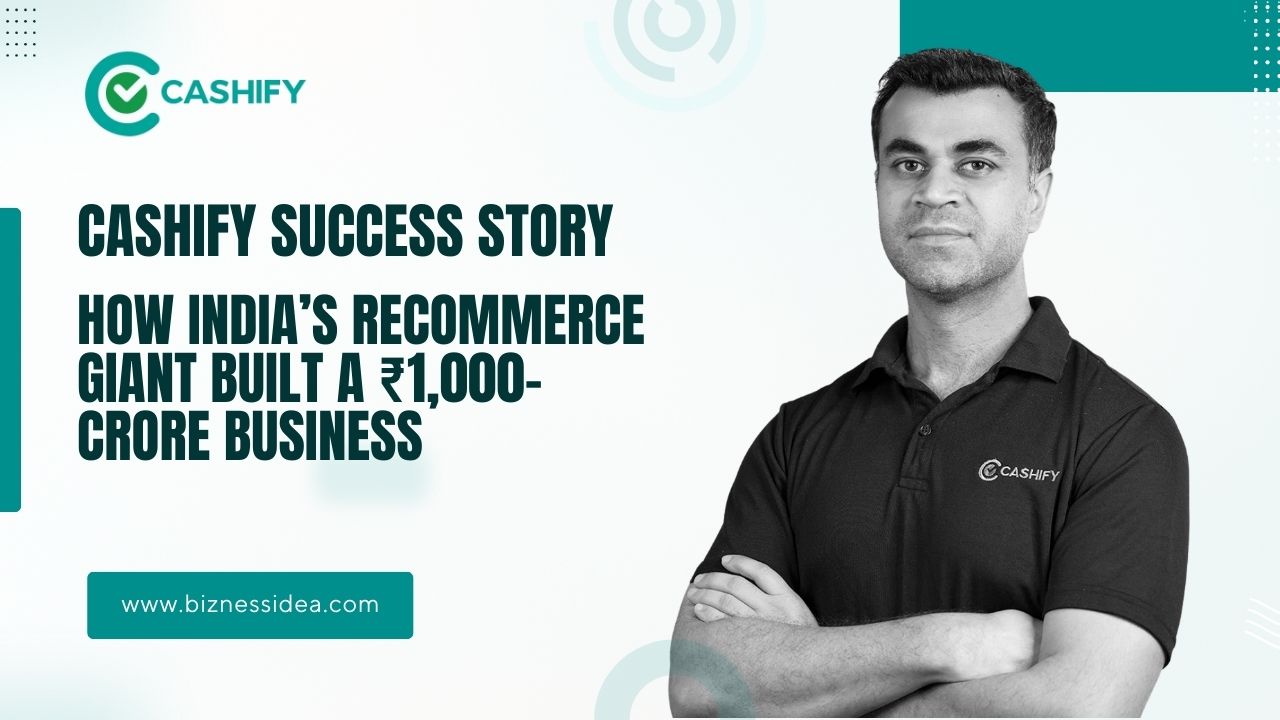Cashify Success Story is nothing short of inspiring — it shows how a simple yet powerful idea of turning old mobile phones into instant cash became one of India’s fastest-growing recommerce startups. For entrepreneurs and startup founders, Cashify’s journey offers valuable lessons in sustainability, scalability, and customer trust.
Why Cashify’s Success Story Matters to Entrepreneurs
In a world where people frequently upgrade their phones, the result is a growing pile of dormant gadgets. Cashify tapped into this need — not just to offer convenience, but to build a circular economy that rewards users, reduces e-waste, and creates value. For entrepreneurial founders, Cashify’s success story is a testament to developing business models that are profitable and environmentally responsible.
How Cashify Identified a Massive Market Gap

The Founders Behind Cashify Success Story
Cashify started as ReGlobe in 2009, co-founded by Mandeep Manocha, Nakul Kumar, and Amit Sethi, originally as a waste-management consulting company. Their experience in recycling made them realize a bigger opportunity: unused electronics in Indian homes, especially old phones.
The Early Struggles Behind Cashify’s Success Story
While waste management was noble, the scaling opportunity lay in recommerce. Around 2012–2013, they saw the need for a structured marketplace to buy used phones. They rebranded to Cashify and began building an ecosystem that could handle buybacks, repairs, and resale.
Business Model Behind Cashify’s Success Story
How Cashify Works (Step-by-Step Model)
- Device Evaluation: Users list their old phones via the app or website.
- Instant Price Quote: Based on age, condition, and model, Cashify offers a quote.
- Doorstep Pickup: Collection is scheduled, and the executive visits you to pick up your device.
- Instant Cash Payment: On pickup, users receive the agreed cash — no hidden fees.
- Refurbishing & Resale: Devices are wiped, repaired, and either resold or recycled.
Cashify Revenue Model Behind Cashify’s Success Story
- Buy-Sell Margin: Cashify buys devices, refurbishes them, and gets a margin on resale.
- Refurbished Device Sales: Sold via their online store and offline locations (PhonePro).
- Repair & Ancillary Services: They also run repair services and accessory sales, adding to revenue.
- Recycling & E-Waste: Devices unfit for repair are responsibly recycled, and some material value is recovered.
The Cashify Success Story and Its Growth Strategy in India
Scaling Decisions That Made the Difference
Cashify recognized early that online alone wouldn’t suffice. It pursued an omnichannel model, opening physical kiosks and stores to increase reach. In 2020, it reported 40% growth in its buyback business and significantly expanded its offline footprint.
Building Trust & Brand
To build consumer trust:
- Cashify uses secure two-pass or three-pass data wiping to keep user data safe.
- It assures transparency in pricing during device evaluation.
- It launched campaigns and partnerships to spread its message of responsible recommerce.
How Funding Fueled the Cashify Success Story & Valuation Growth
- In Series E, Cashify raised $90 million from NewQuest Capital and Prosus, taking its total funding to around $140 million.
- In FY25, Cashify entered the ₹1,000-crore revenue club, showing disciplined cost control and strong topline growth.
- Its losses have sharply reduced — from significant deficits to around ₹10 crore in FY25, marking an 80% reduction.
Partnerships That Made Cashify a Market Leader
Strategic OEM & Retail Tie-Ups
Cashify has forged relationships with top smartphone manufacturers such as Xiaomi, OnePlus, Samsung, and Apple, enabling trade-in programs and direct sourcing.
It also collaborates with major offline retailers like Reliance Retail, contributing to its reach and inventory pipeline.
Expanding Offline Presence
Its offline channel — PhonePro stores and kiosks — brings refurbished devices closer to users. As of its growth phase, Cashify planned to keep scaling its physical footprint.
Innovations That Drove Cashify’s
AI & Technology in Pricing
Cashify uses algorithmic evaluation to assess device value. Factors include age, model, cosmetic condition, and working parts. This helps deliver fast, reasonably accurate quotes that optimize margins and customer satisfaction.
The Refurbishing Ecosystem
At its facilities, devices undergo data wiping, repair, and quality testing. India Today Quality checks are stringent, ensuring refurbished units are reliable.
Logistic and Supply Chain Efficiency
Doorstep collection ensures a smooth customer experience. Recycling centers efficiently disassemble unusable devices, extracting valuable materials in a responsible way.
Challenges Cashify Faced — And What Entrepreneurs Can Learn
Operational & Trust Issues
Convincing users to trust a platform to pick up their old devices wasn’t easy. Cashify addressed this by ensuring transparency in quotes and payment.
Still, some users report customer service issues and sharp downward price adjustments during evaluation.
Scaling Refurbishment
Handling a growing volume of devices inherently risks quality lapses. Cashify’s solution: standard processes, quality control, and partnerships with verified refurbishers.
Economic Cycles & Market Pressure
Even in a slowing organized recommerce market, Cashify maintained growth by focusing on its B2C and direct-to-consumer model.
Cashify’s Impact on India’s Recommerce Industry
Cashify has helped legitimize the recommerce space in India. By making buyback and resale mainstream, it has:
- Educated people about sustainable electronics usage
- Significantly reduced e-waste through responsible recycling programs
- Provided affordable, high-quality refurbished devices to a younger, budget-conscious demographic
Lessons Entrepreneurs Can Learn from the Cashify Success Story
- Solve a real, recurring pain point — Cashify identified unused devices polluting homes.
- Build trust through transparency — Data wiping and clear pricing were essential.
- Combine offline + online — Cashify blended kiosks & e-commerce to scale.
- Integrate sustainability — A social cause (e-waste reduction) can fuel business growth.
- Focus on unit economics — Reducing loss and improving marginal model matters for scale.
Conclusion
Cashify’s success is not just about turning old phones into cash — it’s about creating a circular economy, building a trusted brand, and scaling with purpose. For entrepreneurs, its story underscores the power of solving real problems with sustainable, scalable business models. As Cashify continues to grow, its blend of technology, partnerships, and social impact stands as a blueprint for future recommerce startups in India.
FAQs
Que 1. How does Cashify make money?
Ans. Cashify profits through buy-sell margins on used devices, sales of refurbished smartphones, repair services, and responsible recycling.
Que 2. What is Cashify’s business model?
Ans. Cashify operates a recommerce platform, buying used electronics, refurbishing them, and reselling or recycling them, thereby bridging the gap between consumers and resellers.
Que 3. Who founded Cashify?
Ans. Cashify was co-founded by Mandeep Manocha, Nakul Kumar, and Amit Sethi. It began as ReGlobe, a waste-management business.
Que 4. How does Cashify evaluate old phones?
Ans. Cashify’s executives inspect devices based on age, model, battery health, and cosmetic condition. Then, secure data wiping is performed before refurbishment.
Que 5. Is Cashify a sustainable business?
Ans. Yes — by enabling phone reuse and recycling, Cashify reduces e-waste, supports a circular economy, and offers eco-friendly value to users.
Que 6. What are Cashify’s future plans?
Ans. Cashify plans to expand its offline stores, double its retail footprint, explore B2B partnerships, and go deeper into refurbished device categories beyond mobile phones.













